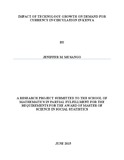| dc.description.abstract | Kenya has undergone major technological developments in banking sector which has increased
efficiency, effectiveness and more so introduction of new forms of payments and new products
in the banking sector. Technology is expected to reduce demand for currency in circulation by
increasing the speed of money circulation, increasing supply, greater diversity of goods whose
money values are transferred by electronic payment instruments, as well as allocation of
electronic balance by some publishers. However, the impact of technological growth on money
demand has received much attention from researchers but there is no still solid evidence on
whether technology growth has reduced demand for currency in circulation. Inspired by the
refutable empirical finding on technology growth and demand for money relationships and
limitations of country specific studies; this study analyzed the impact of technology growth on
demand for currency in circulation in Kenya. The study applied VECM estimation technique and
time series quarterly data for the period 2007 – 2014 to investigate the impact of technology on
demand for currency in circulation. Keynes transaction theory of money demand was used to
establish a link between theory and empirics.
The empirical findings suggest a long-run causality running from the explanatory variables to
demand for currency in circulation and 34% speed of adjustment to equilibrium; implying that
34% of discrepancy in demand of currency in circulation of the previous year is adjusted for the
current year. The results also indicate a short run causality running from commercial lending
interest rates, ATMs and Credit cards to demand for currency in circulation.
Technology growth was found to have a long-run and short run effects on demand for currency
in circulation. In short- run, ATMs and credit cards were found to increase demand for currency
in circulation while mobile money transfer was found to have no impact. GDP and Commercial
lending interest rate were also found to have a long-run impact on the demand for currency in
circulation. Commercial lending interest rates was found to affect demand for currency in
circulation, in that, the higher the commercial lending rates the lesser the demand for currency in
circulation. Previous years’ GDP was found to have no impact on current years’ demand for
currency in circulation.
It could be concluded that technology convert money to electronic forms and this tend to blur the
distinction between monetary and non-monetary assets. It is therefore, prudent for the stability of
the demand for money to be constantly re-examined by the monetary authorities to ensure an
effective control of the monetary base since technological advancement is an ever-changing
continuous process | en_US |

